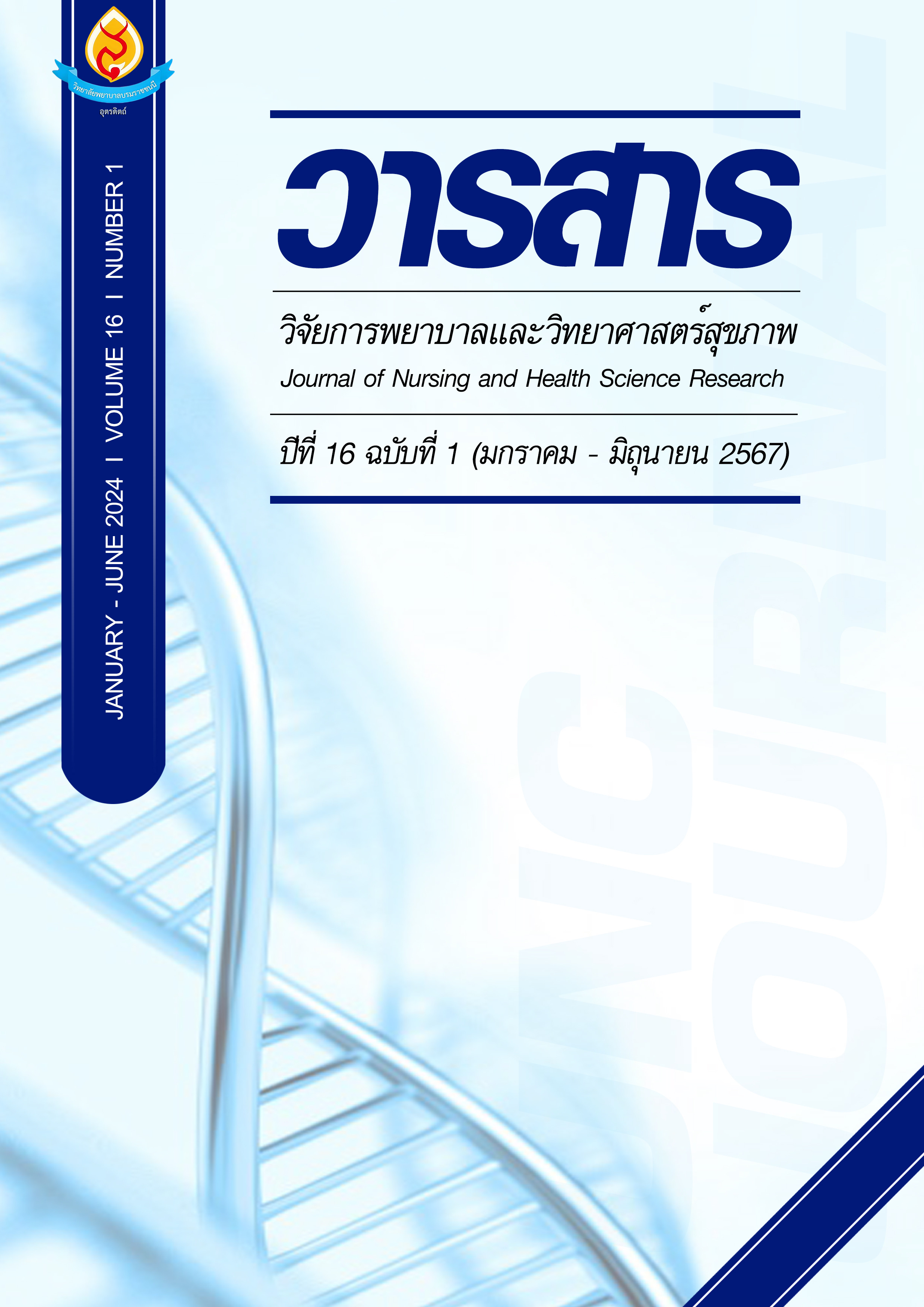การศึกษาภาวะซึมเศร้าและความสัมพันธ์ระหว่างภาวะเครียด ภาวะซึมเศร้า และความมีคุณค่าในตนเอง ในนักศึกษาพยาบาลวิทยาลัยพยาบาลบรมราชชนนี แพร่
Main Article Content
บทคัดย่อ
การศึกษาเชิงพรรณนานี้มีวัตถุประสงค์เพื่อศึกษาภาวะซึมเศร้าและความสัมพันธ์ระหว่างภาวะเครียดและภาวะซึมเศร้า และความรู้สึกมีคุณค่าในตนเอง ในนักศึกษาพยาบาลวิทยาลัยพยาบาลบรมราชชนนี แพร่ กลุ่มประชากรที่ศึกษาเป็นนักศึกษาพยาบาลทุกชั้นปีหลักสูตรประกาศนียบัตรพยาบาลศาสตร์ (เทียบเท่าปริญญาตรี) 2558 ในปีการศึกษา 2562 จำนวน 198 คน เครื่องมือที่ใช้ ได้แก่ แบบประเมินภาวะซึมเศร้า CED-S (Center for Epidemiology Studies-Depression Scale for depression) แบบประเมินความรู้สึกมีคุณค่าในตนเอง (Rubin’s Self Esteem Scale) และแบบประเมินความเครียด (Suanprung Stress Test-20) วิเคราะห์ข้อมูลด้วยสถิติบรรยายและสถิติสัมประสิทธิ์สหสัมพันธ์เพียร์สัน
ผลการศึกษาพบว่า 1) นักศึกษาส่วนใหญ่เป็นเพศหญิง ร้อยละ 92.9 มีอายุเฉลี่ย 21.2 ปี นักศึกษามีภาวะซึมเศร้า คิดเป็นร้อยละ 14.1 2) นักศึกษาพยาบาลมีความเครียด ระดับปานกลาง (Moderate) ร้อยละ 54.0 ระดับสูง (High) ร้อยละ 36.9 และระดับระดับรุนแรง (severe) คิดเป็นร้อยละ 5.1 3) ความมีคุณค่าในตนเองของนักศึกษาพยาบาล พบว่านักศึกษามีคุณค่าในตนเองระดับปานกลาง (modurate) ร้อยละ 73.2 และความมีคุณค่าตนเองในระดับสูง (high) ร้อยละ 26.8 4) ความมีคุณค่าในตนเองกับภาวะซึมเศร้ามีความสัมพันธ์ในทางตรงกันข้ามในระดับปานกลางค่าสัมประสิทธิ์สหสัมพันธ์เท่ากับ -.52 ส่วนภาวะเครียดและภาวะซึมเศร้ามีความสัมพันธ์กันที่ระดับนัยสำคัญทางสถิติที่ .01
ข้อเสนอแนะในการศึกษาครั้งต่อไป
1. ควรศึกษาตัวแปรด้านอื่น ๆ ที่เกี่ยวข้องกับความเครียดและสุขภาพจิตของนักศึกษา เช่น การปรับตัว การเรียน ปัญหาภาวะทางเศรษฐกิจในครอบครัว แรงจูงใจ เป็นต้น
2. ควรศึกษาวิจัยเชิงทดลองเกี่ยวกับผลของการใช้โปรแกรมที่จะสามารถลดภาวะเครียดและภาวะซึมเศร้าในกลุ่มนักศึกษาพยาบาล
Article Details

อนุญาตภายใต้เงื่อนไข Creative Commons Attribution-NonCommercial-NoDerivatives 4.0 International License.
บทความหรือข้อคิดเห็นใดใดที่ปรากฏในวารสารวิจัยการพยาบาลและวิทยาศาสตร์สุขภาพ เป็นวรรณกรรมของผู้เขียน ซึ่งบรรณาธิการหรือสมาคมศิษย์เก่า ไม่จำเป็นต้องเห็นด้วย และบทความที่ได้รับการตีพิมพ์เผยแพร่ถือเป็นลิขสิทธิ์ของวารสารวิจัยการพยาบาลและวิทยาศาสตร์สุขภาพ
เอกสารอ้างอิง
Chen, C. J., Chen, Y. C., Sung, H. C., Hsieh, T. C., Lee, M. S. & Chang, C. Y. (2015). The prevalence and related factors of depressive symptoms among junior college nursing students: a cross-sectional study. Journal of Psychiatric and Mental Health Nursing, 22(8), 590–598.
Department of Mental Health Ministry of Public Health. (2018). Activity guide “practice problem solving, develop EQ” (For the center for friends of the heart of teenagers). Nonthaburi. Printing House, Agricultural Cooperative Association of Thailand. Co., Ltd.
Furegato, A. R. F., Santos, J. L. F. & Silva, E.C. (2008). Depression among nursing students associated to their self-esteem. health perception and interest in mental health,16(2), 198-204.
Gong, S. J. & Lee, E. H. (2006). Meditation effect of coping between life stress and depression in female college students. Korean Journal of Women Psychology, 11, 2140
Haack, M. R. (1985). Antecedents of the impaired nurse: Burnout, depression and substance use among student nurses. Unpublished doctoral dissertation, University of Illinois at Chicago.
Haack, M. R. (1988). Stress and impairment among nursing students. Nursing & Health Care, 11, 125-134.
Han, K. S. (2005). Self efficacy health promoting behaviors and symptoms of stress among university students. Journal of Korean Academy of Nursing, 35(3), 585-592.
Kang, J., Ko, Y. K., Lee, H. K., Kang, K. H., Hur, Y. & Lee, K. H. (2013). Effects of self-esteem and academic stress on depression in Korean students in health care professions. Journal of Korean Academy of Psychiatric and Mental Health Nursing, 22(1), 56-64.
Kim, O. S. & Kim, K. H. (2001). Social support, depression, drinking and smoking in college and working females. Journal of Korean Academy of Adult Nursing, 13, 363372.
Kim, C. H. & Lee, M. K. (2006).The effect of personality style and interpersonal problems solving ability on life stress, depression. Korean Journal of Health Psychology, 1, 163-175.
Mahatnirunkul, S., Poomphaisanchai, W. & Tapanya, P. (1996). Construction of a stress measurement model. Suanprung. Journal of Suanprung, 13, 1-20. (in Thai).
Park, H. S., Son, C. N. & Oh, S.W. (1993). The effects of stress, social support, dysfunctional attitude and coping style upon depression. Korean Journal of Clinical Psychology, 12, 179-196.
Papazisis, G., Nicolaou, P., Tsiga, E., Christoforou, T. & Sapountzi Krepia, D. (2014). Religious and spiritual beliefs, self-esteem, anxiety, and depression among nursing students. Nursing and Health Sciences, 16(2), 232-238.
Risal, A., Sanjel, S. & Sharma, P. P. (2016). Study of depression among the nursing students in a university medical college of Nepal. Kathmandu University Medical Journal, 55(3), 264-278.
Xu, Y. et al. (2014). Prevalence and correlates of depression among college nursing students in China. Nurse Education Today, 34(6), e7–e12.
Zoccolillo, M., Murphy, G. E. & Wetzel, R. D. (1986). Depression among medical students. Journal of affective disorders, 11(1), 91-96.


